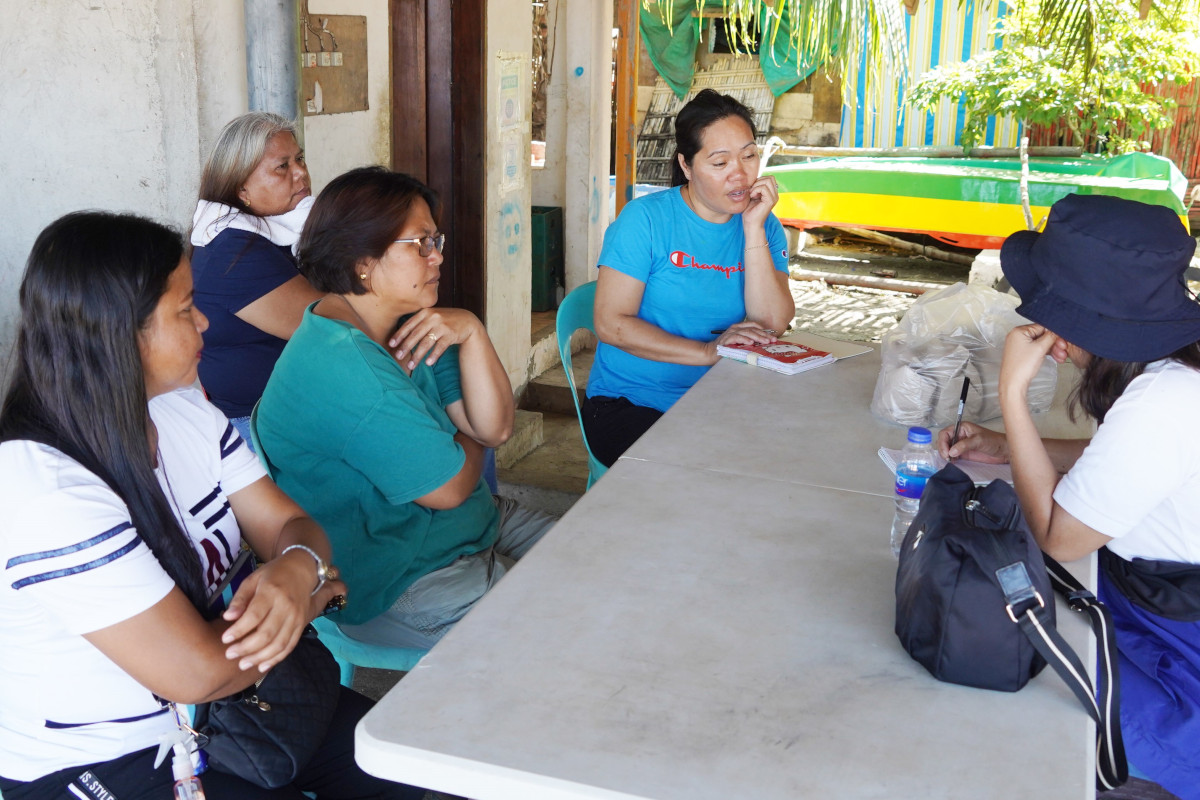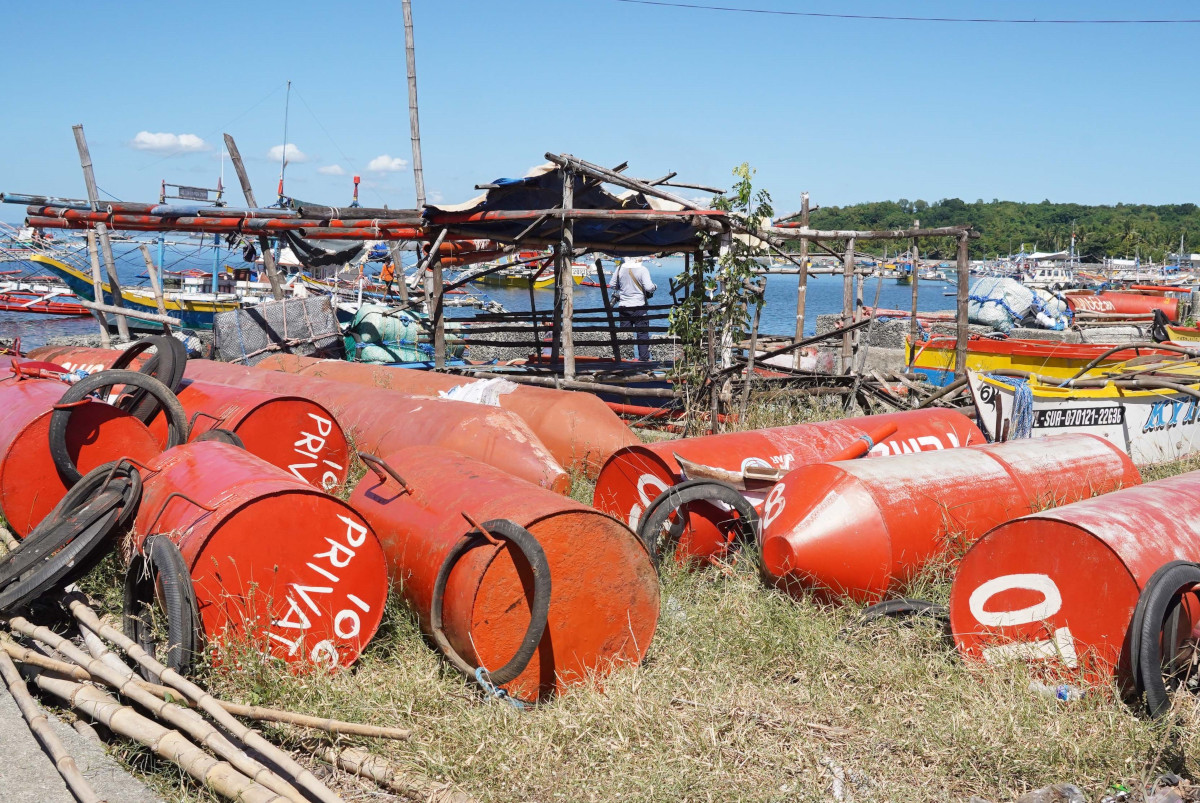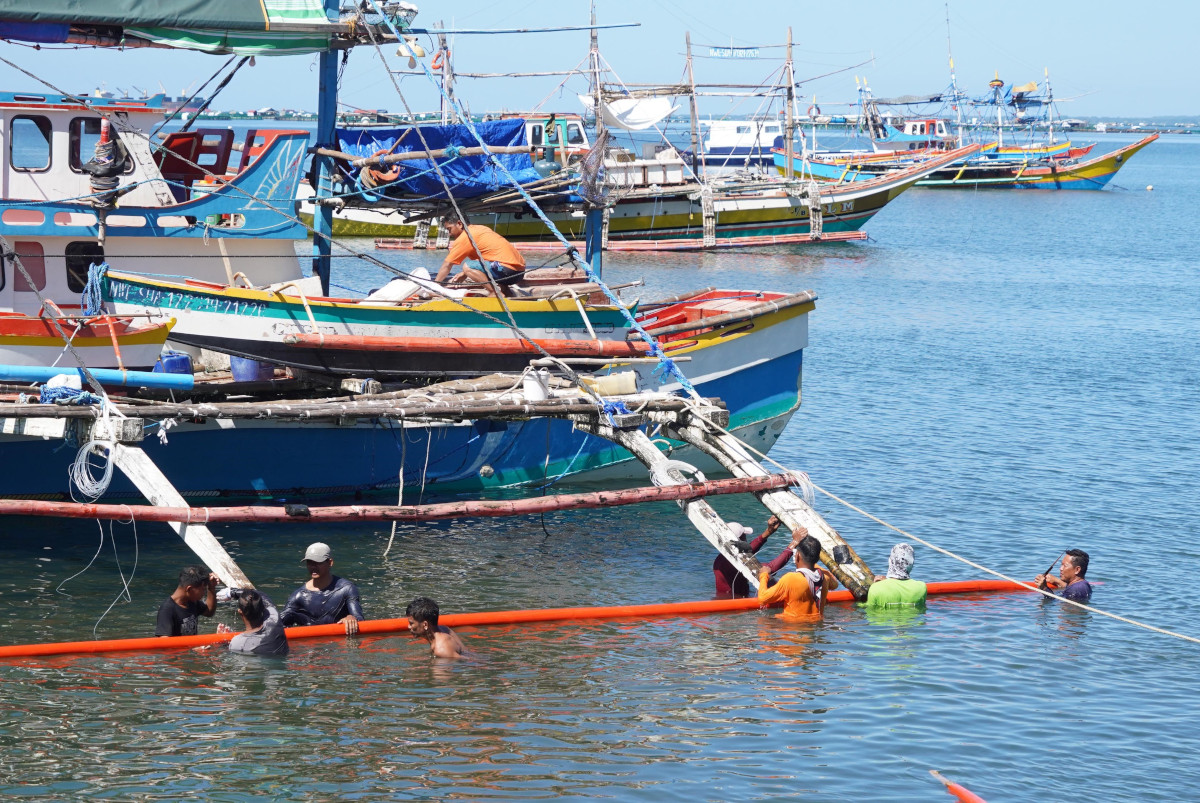MASINLOC, Zambales – Dina Evalan, 62, recalls the days when fishing was a profitable activity in the town. Fishermen like her husband Jacinto used to bring home abundant catch, fetching a neat income for the family.
“Nuon, ang paglalaot ay maganda, maraming huli, masagana ang buhay namin. Ngayon, may nangyaring ‘di maganda sa laot kung saan may naghahari-harian, kaya halos wala na sila nahuhuling isda. Sa konsulmo wala pang naibabalik dahil sa kakulangan ng isda. Kailangang malayong-malayo talaga ang puntahan nila,” Evalan narrates.
(Back then, fishing was good, the catch was plenty and we had a good life. Nowadays, something unpleasant happened in the sea where someone wants to reign so the local fishermen’s catch has dwindled. It’s almost break-even due to scarcity of the fish. They have to go really far out to the sea to look for fish.)
Things started to fall apart in 2012 when Chinese Coast Guard vessels arrived and surrounded the Scarborough Shoal, scaring Filipino fishermen with water cannons, blaring horns, and forms of threats.
Thus, the family’s income plunged, forcing Evalan to work as a housemaid to augment her husband’s take-home pay as a fisherman.
Evalan’s husband, Jacinto, has never ventured to the shoal, which is tightly guarded by the Chinese Coast Guard after China claimed it as part of its territory.


Scarborough Shoal, also known as Panatag Shoal and Bajo de Masinloc in the West Philippine Sea, is a triangular-shaped chain of reefs and rocks around a 150-kilometer (km)-wide lagoon, 220 km from Masinloc. It is well within the 200-nautical mile (370 km) Philippine exclusive economic zone.
Tougher competition for depleting fish populations
Municipal fishermen, although they don’t venture out into the shoal, are also affected by China’s incursions.
Those who used to go to the shoal now fish in municipal waters, competing with depleting fish populations.
“Marami nang nag-aagawan sa isda duon kaya kaunti na ang huli na halos pang-ulam na lang, said Gina Edora, 39.
(Many of us are scrambling for the fish there, leaving us catching fish that is barely enough for the family’s consumption.)
Like Evalan, other fishermen’s wives have to take odd jobs to make ends meet.
Edora and Geraldine Barnacha, 40, work at the San Miguel power coal-fired power plant in the town as first aiders during the plant’s annual shut down. Barnacha said they underwent training as first aiders by the Philippine Red Cross so they can work at the plant.
“Pinagtiya-tiyagaan namin para may dagdag kita, maski minimum lang ang sweldo. But mostly, we sell fish caught by our husbands. But yesterday, my husband Israel was able to bring home only two pieces of tuna weighing a total of three kilos,” Barnacha said.
(We make do with it for additional income, even if the pay is just the minimum rate.)
Evalan, Edora and Barnachan said fishermen’s wives like them cannot depend on the sea anymore for their livelihood.
Like the fishermen in Masinloc, Zambales, those in Infanta, Pangasinan some 50 kilometers away, have also lost Scarborough Shoal as their traditional fishing ground.
They have been avoiding Scarborough Shoal, located some 246 kilometers (130.8 nautical miles) away from the town’s shore and which yielded a big volume of fish every fishing expedition.
They do not want to run the risk of clashing with the Chinese Coast Guard patrolling the shoal perimeters.
Lilibeth Quintero, 43, said her husband Canbrano, 47, used to fish in the Scarborough Shoal using FV John Glayford, a commercial fishing boat. The fishing carries six pakuras (small boats), which are brought down and used by crew members to enter payaw areas to catch fish, using hand lines.
But not anymore. Like the others, he got scared after his fishing boat was water cannoned in 2012 at the height of the Chinese incursion of the shoal.
“Maraming huli nuon,” Quintero recalls, “wala kaming problema sa gastusin.”
(There was abundant catch before, so we had no problem with expenses.)
No giving up
They may have “lost” the shoal, but Filipino fishermen are undaunted, refusing to give up the only source of livelihood they know and indulging in for a long time.
When it became clear that the shoal was no longer easily accessible to them, investors and commercial boat operators started establishing payaw or fish aggregating devices (FAD) which became their alternate fishing ground.


Frederick Naboa, president of the Cato, Infanta Fishermen’s Association, says the FADs are placed some 80 nautical miles from the shore. The payaw nearest to Scarborough is about 20 miles away, he adds.
Fisheries Administrative Order 244-2012 defines FAD as man-made structures in fishing grounds to lure pelagic fish species, notably tuna and round scads.
Payaw, according to Prospero Pastoral of the Bureau of Fisheries and Aquatic Resources, is a “fish shelter operated by fishermen designed to attract or lure fish.”
“It is an anchored floating or submerged material or raft usually made of bamboo, steel, or other materials which is a line or lines with sinkers on which are attached coconut leaves, twigs, bundles of trees or plastic strips netting,” Pastol said in his paper titled “Benefits derived from and problems encountered in the use of payaw among tuna fishermen in the Philippines.”
He explained that algae grows in payaw’s parts like the leaves and ropes, and these attract small fishes. Big fishes are, in turn, attracted by the presence of small fishes and feed on them in what is called food chain or prey-predator relationship. He added that fishes have sheltering or harboring behavior so they go to the payaw areas.
“Dati ilan lang ang payaw. Pero nagsulputan na nang humigpit ang pagpasok sa Scarborough, Naboa said.
(There used to be a few payaw. But they have mushroomed when it became difficult to enter Scarborough.)
While spears are used to catch fish in the shoal, fishermen from Infanta use handlines to catch yellowfin, tanigue, dorado and other species, in the payaw areas. Handline fishing means holding a line with a hook or several hooks on which baits are attached. When a fish bites the bait, the fishermen pull the line to the boat.
There are no official records on the number of payaw, which were deployed some 100-120 miles from the shoreline. Payaw investors find their place in the sea but must ensure that they are located 5-10 miles apart, to ensure that the ropes of each do not entangle.
The fishermen/investors in Infanta have designed their own FAD that can be deployed far into the sea, using a steel floater, 10 rolls of 18-millimeter nylon ropes (660 meters), 34 pieces of rubber rings, and four drums (filled with mixed cement) used as sinkers Attached to the ropes are buri leaves, which serve as “shelter” and spawning ground for the pelagic fishes. The buri leaves are changed when they are already rotting.
The cost of materials for a payaw runs to as much as P156,000, Naboa said. “Bayanihan” is practiced among the fishermen in deploying the payaw, which takes two to three days. If they would add the cost for labor, it could be an additional P25,000 to P50,000 for deployment, Naboa added.
Quintero said the payaws are open to all CFVs who want to catch fish, but they must give a share of the catch to the owner.
This is where honesty of the fishermen shines, as they disclose the volume of their catch, which will be the basis for the share of the payaw owners.
When asked if there are instances of “cheating,” Naboa said, “yes,” but this is usually exposed by the CFV crew themselves during drinking binges.
While the payaws are good fishing grounds, they are not harvest-ready for the entire year. The months of February to May are spawning season for the fishes so it won’t be worthwhile to go fishing there, as the fishes are still small, Naboa said.
Also, every time there is malakas, fishermen could not go out to the payaw areas, and both CFV operators and workers do suffer financially. Malakas is the locals’ term for hanging amihan or habagat ( northeast or southwest monsoon), which spawn strong winds and rough waves in the sea.
Coping with lower income, Quintero said housewives resort to diskarte (smart moves), utang (borrowing), and pagtitipid (frugality) to make ends meet. “I also make and sell kakanin (rice cakes), banana cue.”
Esperanza Meru, 50, said that when the fishing boats come back empty-handed, the operators suffer as the workers depend on them for household expenses for food, utilities and even for their children’s provisions for school.
The Infanta fishermen still wish that Scarborough Shoal will soon be open to them again as it yields abundant, bigger and more fish varieties, Quintero said.
Hide and seek at sea
They do dare head to the Scarborough Shoal during the spawning months in the payaw areas where they play “hide and seek” with the Chinese Coast Guard.
Darkness is the fishermen’s best friend when they are on the shoal. They wait for the night to enter the shoal’s lagoon where fish varieties are bountiful. They anchor their big fishing boats kilometers away, then wait for sunset when the Chinese vessels leave the site.
With the Chinese gone, the fishermen enter the lagoon, using pakura or their individual small boats. They exit from the lagoon and head to the mother boats just before the sun rises the following day.


Ricky Etac, 52, said he does not dare go near the lagoon in the daytime, fearful of experiencing again a traumatic incident that took place some years back.
His wife Maritess, 50, said the fishermen’s wives are left behind at home, worriedly waiting for the return of their husbands after learning about the encounters between the locals and the Chinese, with the Chinese training water hoses at them to chase them away.
“When they get back to shore, they will show us the video they shot while they are scampering away from the Chinese, drenched in water,” Maritess said.
Aside from losing their fishing grounds, the fishermen have to contend with unpredictable weather and natural occurrences that make it dangerous for them to go to the sea.
On Nov. 16, at least 60 commercial fishing boats were docked at the Cato pier. Not one CFV ventured out into the sea as authorities prevented them from leaving.
It was the fourth day that there were no fishing activities in the West Philippine Sea because there is malakas, said Naboa.
It took another week before they were allowed to go fishing again. This means no income for the local fishermen who depend on the sea’s bounty for livelihood.
Christopher De Vera Sr., 54, could just wander around the pier where FB Legendary, which he commands as a skipper, has been moored since Nov. 12.
De Vera is the only CFV operator from Infanta who still regularly goes out into the Scarborough Shoal. On Nov. 11, while he was in the vicinity of Scarborough Shoal, the Philippine Navy radioed all fishing boats to return to shore.
“Lugi kami (we lost) ng P21,000,” he rued, lamenting that he spent P142,000 for the supposedly week-long fishing trip that was cut to three days. When asked if the Chinese Coast Guard does not scare him, he said, “Lakasan lang ng loob (I try to be courageous).” He said he has memorized the numbers of the Chinese Coast Guard vessels that patrol the shoal and which he had raced with.
“Nuong Aug. 14, nakipagkarera ako sa coast guard na may numerong 3106 at 3301. May parating na bagyo nuon kaya naglakas loob akong pumasok sa lagoon. Nandu’n na ang dalawang maliit na Chinese Coast Guard na may marking 3663 at 3064. ‘Di naman ako pinaalis, kasi siguro isa lang naman ako, at may bagyong parating,” he recalled.
On Aug. 18, a Chinese navy vessel marked 3106 and 3107 with water cannons arrived and blared their horns, “bellowing at us to leave the shoal.”
“Buwis buhay talaga,” De Vera said.
Still, he is undeterred. He left for the shoal on Nov. 9 and saw at least four big Chinese Coast Guard ships marked 3501, 3302, 3304, 3106, two small ones marked 3065 and 3066, and Chinese maritime militia vessels with numbers 0002, 00309, and 00307.
A scary, although a “little bit funny” incident occurred last Sept. 30, De Vera said. The Chinese Coast Guard went down the vessel on a rubber boat and “came near us.”
“They were just half a mile away from us and blared through the megaphone the words ‘leave imme-di-yet-ly’ in halting English for about an hour. They were reading what they were shouting, and whenever they pronounced the words wrong, they laughed at themselves,” De Vera recounted in Filipino.
The local fishermen stood their ground, and finally, the Chinese left and boarded their vessel marked 3106, leaving De Vera in peace to do his fishing job.


